高性能分布式限流:Redis+Lua真香!
什么是限流?为什么要限流?
限流,这个词其实并不陌生,在我们生活中也随处可见。做核酸时,工作人员会在核酸检测点的空地上摆放着弯弯曲曲的围栏,人们排着队左拐右拐的往前移动,其实这么做的目的就是限流!因为核酸检测的窗口是有限的,一下子进那么多人,没那么多空间让人们站下,就会造成拥挤,甚至会造成事故。所以需要限流!
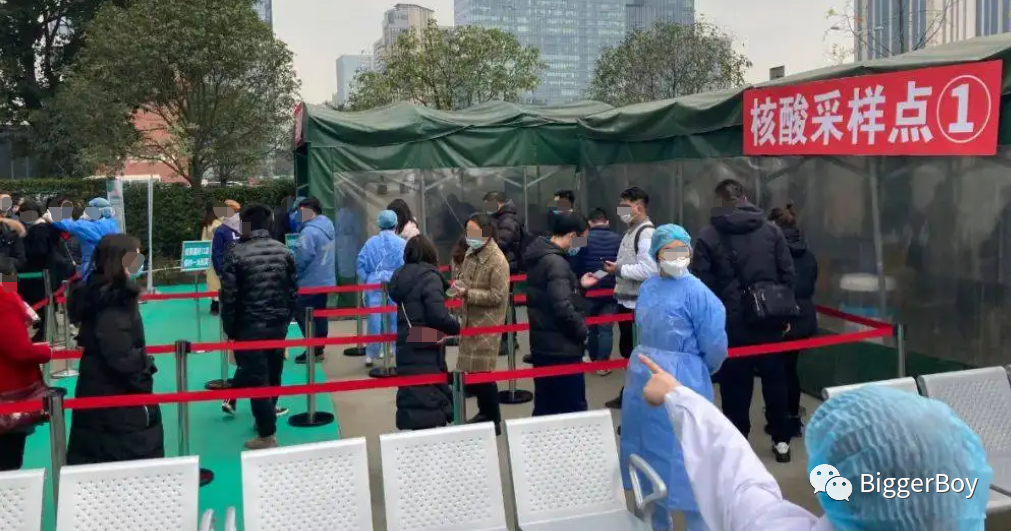
图源网络
同样的,我们的应用程序也是类似的,任何系统它处理请求的能力都是有限的,一旦请求多到超出系统的处理极限,系统就会崩溃。对于生产环境,崩溃是一个很大的生产事故,保不准就会给公司造成很大的损失,轻则赔款,重则判刑都是有可能的。所以今天我们就来聊一下如何实现高性能的限流。
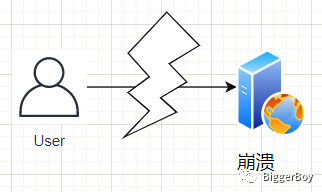
重试、限流、熔断、降级被称为分布式系统高可用的四板斧。
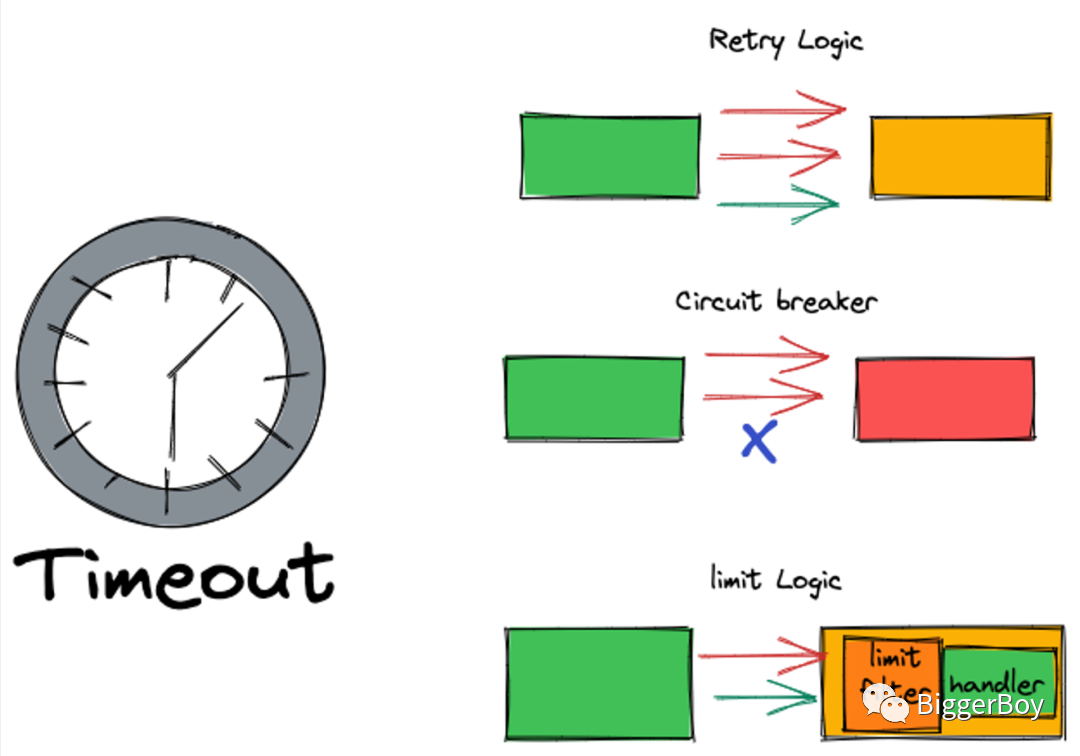
图源infoQ
不可避免地,
第一,我们一定要设置超时;
第二,要在一些场景里面去考虑重试的逻辑;
第三,考虑熔断的逻辑,不要被下游拖死;
第四,一定要有限流的逻辑,不要被上游打死。
当今社会,互联网公司的流量巨大,系统上线前需要对系统进行全面的流量峰值评估,以判断系统所能承载的最大瞬时请求数,尤其是像各种秒杀促销活动,为了保证系统不被巨大的流量压垮,会事先评估系统最大请数,并设置限流逻辑,以便在系统流量到达设定的阈值时,拒绝掉这部分流量,从而确保系统不会崩溃。
限流会导致用户在短时间内(这个时间段是毫秒级的)系统不可用,假设系统设置的每秒流量阈值是100,理论上一秒内第101个及之后的请求都会被限流,相当于拒绝服务,下一秒进来的请求能正常被响应,这也就是为什么我们抢购时,一会儿能进页面一会儿显示“请稍后”之类的提示语。相比于系统的短暂不可用,要比系统崩溃要好太多了。
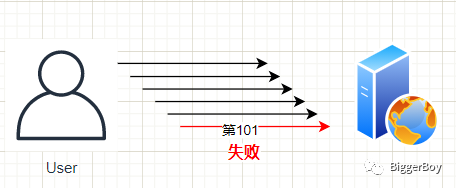
对于限流有很多方式,最经典的几种就是,计数器法、滑动窗口、漏桶法、令牌桶等,今天北哥要讲的是采用Redis + Lua脚本实现高性能的分布式限流,下面就跟着北哥来一起实战吧。
分布式限流
所谓的分布式限流,其实道理很简单。分布式区别于单机限流的场景,它把整个分布式集群环境中所有服务器当做一个整体来考量。比如说针对IP限流,我们限制了1个IP每秒最多10个访问,不管来自这个IP地址的请求落在了哪台机器上,只要是访问了集群中的服务节点,那么都会受到限制规则的制约。
从上面的例子不难看出,我们必须将限流信息保存在一个“中心化”的组件上,这样它就可以获取到集群中所有机器的访问状态。

目前有两个比较主流的限流方案:
- 网关层限流。将限流规则应用在所有流量的入口处
- 中间件限流。将限流信息存储在分布式环境中某个中间件里(比如redis),每个组件都可以从这里获取到当前时间的流量统计,从而决定是否放行还是拒绝。
Redis+Lua实现高性能分布式限流
这篇文章介绍Redis+Lua实现分布式限流,很多小伙伴不知道Lua是什么,个人理解,Lua脚本和 MySQL数据库的存储过程比较相似,他们执行一组命令,所有命令的执行要么全部成功或者失败,以此达到原子性。也可以把Lua脚本理解为,一段具有业务逻辑的代码块。
而Lua本身就是一种编程语言(脚本语言),Redis 脚本使用 Lua 解释器来执行脚本。Reids 2.6 版本通过内嵌支持 Lua 环境。执行脚本的常用命令为 EVAL。详细参考https://www.redis.net.cn/tutorial/3516.html
虽然Redis 官方没有直接提供限流相应的API,但却支持了 Lua 脚本的功能,可以使用它实现复杂的令牌桶或漏桶算法,也是分布式系统中实现限流的主要方式之一。
并且通常我们使用Redis事务时,并不是直接使用Redis自身提供的事务功能,而是使用Lua脚本。相比Redis事务,Lua脚本的优点:
- 减少网络开销:使用Lua脚本,无需向Redis 发送多次请求,执行一次即可,减少网络传输
- 原子操作:Redis 将整个Lua脚本作为一个命令执行,原子,无需担心并发
- 复用:Lua脚本一旦执行,会永久保存 Redis 中,,其他客户端可复用
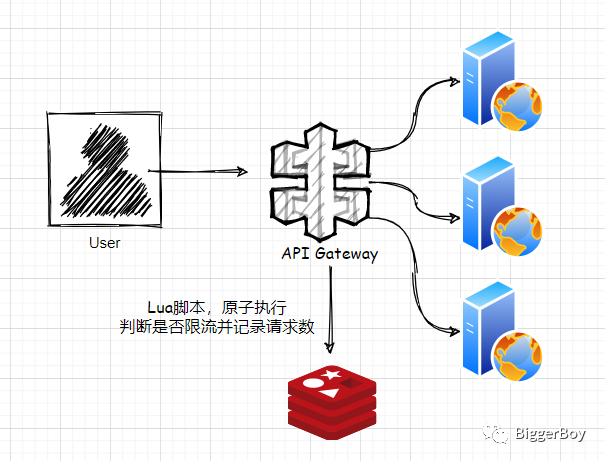
Lua脚本大致逻辑如下:
-- 获取调用脚本时传入的第一个key值(用作限流的 key)
local key = KEYS[1]
-- 获取调用脚本时传入的第一个参数值(限流大小)
local limit = tonumber(ARGV[1])
-- 获取当前流量大小
local curentLimit = tonumber(redis.call('get', key) or "0")
-- 是否超出限流
if curentLimit + 1 > limit then
-- 返回(拒绝)
return 0
else
-- 没有超出 value + 1
redis.call("INCRBY", key, 1)
-- 设置过期时间
redis.call("EXPIRE", key, 2)
-- 返回(放行)
return 1
end- 通过KEYS[1] 获取传入的key参数
- 通过ARGV[1]获取传入的limit参数
- redis.call方法,从缓存中get和key相关的值,如果为null那么就返回0
- 接着判断缓存中记录的数值是否会大于限制大小,如果超出表示该被限流,返回0
- 如果未超过,那么该key的缓存值+1,并设置过期时间为1秒钟以后,并返回缓存值+1
实战
首先创建一个springboot项目,在pom.xml中引入依赖:
<dependency>
<groupId>org.springframework.boot</groupId>
<artifactId>spring-boot-starter-data-redis</artifactId>
</dependency>
<dependency>
<groupId>redis.clients</groupId>
<artifactId>jedis</artifactId>
</dependency>
<dependency>
<groupId>com.google.guava</groupId>
<artifactId>guava</artifactId>
<version>21.0</version>
</dependency>
<dependency>
<groupId>org.springframework.boot</groupId>
<artifactId>spring-boot-starter-aop</artifactId>
</dependency>
<dependency>
<groupId>org.apache.commons</groupId>
<artifactId>commons-lang3</artifactId>
<version>3.9</version>
</dependency>
<dependency>
<groupId>org.projectlombok</groupId>
<artifactId>lombok</artifactId>
<optional>true</optional>
</dependency>配置RedisTemplate
首先application.properties配置Redis连接信息
spring.redis.host=127.0.0.1
spring.redis.port=6379
spring.redis.database=0然后通过@Bean配置RedisTemplate
import org.springframework.context.annotation.Bean;
import org.springframework.context.annotation.Configuration;
import org.springframework.data.redis.connection.RedisConnectionFactory;
import org.springframework.data.redis.connection.jedis.JedisConnectionFactory;
import org.springframework.data.redis.core.RedisTemplate;
import org.springframework.data.redis.serializer.GenericJackson2JsonRedisSerializer;
import org.springframework.data.redis.serializer.StringRedisSerializer;
import java.io.Serializable;
/**
* redis配置类.
*
* @author : 北哥 公众号:BiggerBoy
* @version : 1.0 2022/09/09
* @since : 1.0
*/
@Configuration
public class RedisConfig {
@Bean
JedisConnectionFactory jedisConnectionFactory() {
return new JedisConnectionFactory();
}
@Bean
public RedisTemplate<String, Serializable> limitRedisTemplate(RedisConnectionFactory redisConnectionFactory) {
RedisTemplate<String, Serializable> template = new RedisTemplate<>();
template.setKeySerializer(new StringRedisSerializer());
template.setValueSerializer(new GenericJackson2JsonRedisSerializer());
template.setConnectionFactory(redisConnectionFactory);
return template;
}
}创建自定义注解
然后我们创建自定义注解:
import com.biggerboy.redislimiter.enums.LimitType;
import java.lang.annotation.*;
/**
* redis限流注解.
*
* @author : 北哥 公众号:BiggerBoy
* @version : 1.0 2022/09/09
* @since : 1.0
*/
@Target({ElementType.METHOD, ElementType.TYPE})
@Retention(RetentionPolicy.RUNTIME)
@Inherited
@Documented
public @interface MyRedisLimiter {
/**
* 缓存到Redis的key
*/
String key();
/**
* Key的前缀
*/
String prefix() default "limiter:";
/**
* 给定的时间范围 单位(秒)
* 默认1秒 即1秒内超过count次的请求将会被限流
*/
int period() default 1;
/**
* 一定时间内最多访问的次数
*/
int count();
/**
* 限流的维度(用户自定义key 或者 调用方ip)
*/
LimitType limitType() default LimitType.CUSTOMER;
}创建切面类RedisLimitAspect
大致逻辑是获取方法上的注解MyRedisLimiter,从注解上获取配置信息,组装keys和参数,然后调用RedisTemplate的execute方法获取当前时间内请求数,小于等于limitCount则不限流,否则限流降级处理。
/**
* @param pjp
* @author 问北(北哥) 公众号:BiggerBoy
* @description 切面
* @date 2022-9-8 18:29:53
*/
@Around("execution(public * *(..)) && @annotation(com.wenbei.annotation.MyRedisLimiter)")
public Object limit(ProceedingJoinPoint pjp) {
MethodSignature signature = (MethodSignature) pjp.getSignature();
Method method = signature.getMethod();
MyRedisLimiter limitAnnotation = method.getAnnotation(MyRedisLimiter.class);
LimitType limitType = limitAnnotation.limitType();
int limitPeriod = limitAnnotation.period();
int limitCount = limitAnnotation.count();
String key = getKey(limitAnnotation, limitType);
ImmutableList<String> keys = ImmutableList.of(StringUtils.join(limitAnnotation.prefix(), key));
try {
Number count = limitRedisTemplate.execute(redisScript, keys, limitCount, limitPeriod);
logger.info("try to access, this time count is {} for key: {}", count, key);
if (count != null && count.intValue() <= limitCount) {
return pjp.proceed();
} else {
demote();//降级
return null;
}
} catch (Throwable e) {
if (e instanceof RuntimeException) {
throw new RuntimeException(e.getLocalizedMessage());
}
throw new RuntimeException("服务器出现异常,请稍后再试");
}
}到这里,最关键的Lua是如何使用的还没讲到。我们可以看到上述代码调用limitRedisTemplate.execute参数的第一个是redisScript,这便是Redis用于执行Lua脚本的重要支持。
加载Lua脚本
在切面类中,我们可以通过初始化加载Lua脚本,如下new ClassPathResource(LIMIT_LUA_PATH)
private static final String LIMIT_LUA_PATH = "limit.lua";
private DefaultRedisScript<Number> redisScript;
@PostConstruct
public void init() {
redisScript = new DefaultRedisScript<>();
redisScript.setResultType(Number.class);
ClassPathResource classPathResource = new ClassPathResource(LIMIT_LUA_PATH);
try {
classPathResource.getInputStream();//探测资源是否存在
redisScript.setScriptSource(new ResourceScriptSource(classPathResource));
} catch (IOException e) {
logger.error("未找到文件:{}", LIMIT_LUA_PATH);
}
}我们传入常量limit.lua,这是classpath下创建的脚本文件,Lua脚本如下,也很简单,就不在赘述。通常应该在limit.lua文件中放置脚本文件,这样如果需要修改脚本,仅需要修改文件重启即可。
local count
count = redis.call('get',KEYS[1])
--不超过最大值,则直接返回
if count and tonumber(count) > tonumber(ARGV[1]) then
return count;
end
--执行计算器自加
count = redis.call('incr',KEYS[1])
if tonumber(count) == 1 then
--从第一次调用开始限流,设置对应key的过期时间
redis.call('expire',KEYS[1],ARGV[2])
end
return count;降级
然后在降级方法中写我们的降级逻辑,通过抛异常或往HttpServletResponse写入返回信息都可以。
/**
* 降级策略
* @author 北哥
* @date 2020/4/8 13:24
*/
private void demote() {
logger.info("try to access fail, this request will be demoted");
//throw new RuntimeException("限流了");
response.setHeader("Content-Type", "text/html;charset=UTF8");
PrintWriter writer = null;
try {
writer = response.getWriter();
writer.println("访问失败,请稍后再试...");
writer.flush();
} catch (Exception e) {
e.printStackTrace();
} finally {
if (writer != null) {
writer.close();
}
}
}接口限流
好了,准备工作都ok了,下面我们在controller接口上加上注解,测试一下。
/**
* 测试限流controller
* @author 北哥 公众号:BiggerBoy
* @date 2022年9月8日17:02:40
*/
@RestController
public class TestLimiterController {
/**
* @author 北哥
* @description
* @date 2020/4/8 13:42
*/
@MyRedisLimiter(key = "limitTest", count = 2)
@RequestMapping(value = "/limitTest")
public Long limitTest() {
System.out.println("limitTest");
return 1L;
}
/**
* @author 北哥
* @description
* @date 2020/4/8 13:42
*/
@MyRedisLimiter(key = "customer_limit_test", period = 10, count = 3, limitType = LimitType.CUSTOMER)
@GetMapping("/limitTest2")
public Integer testLimiter2() {
System.out.println("limitTest2");
return 1;
}
/**
* @author 北哥
* @description
* @date 2020/4/8 13:42
*/
@MyRedisLimiter(key = "ip_limit_test", period = 10, count = 3, limitType = LimitType.IP)
@GetMapping("/limitTest3")
public Integer testLimiter3() {
System.out.println("limitTest3");
return 3;
}
}测试
接口限制每秒2个请求,我们使用jmeter1秒发10个请求
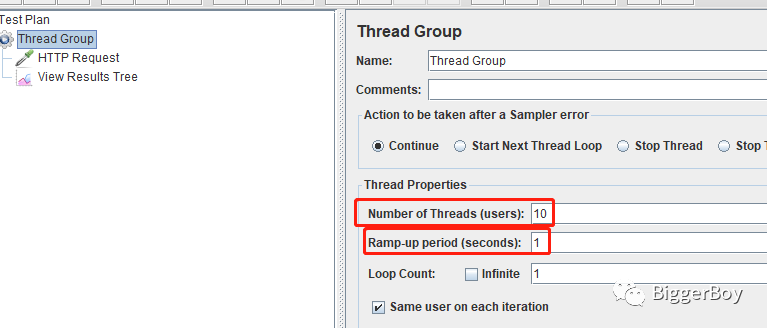
结果只有前两个成功了(上述降级采用的直接抛异常,方便在这里看到限流时下面时红色的)
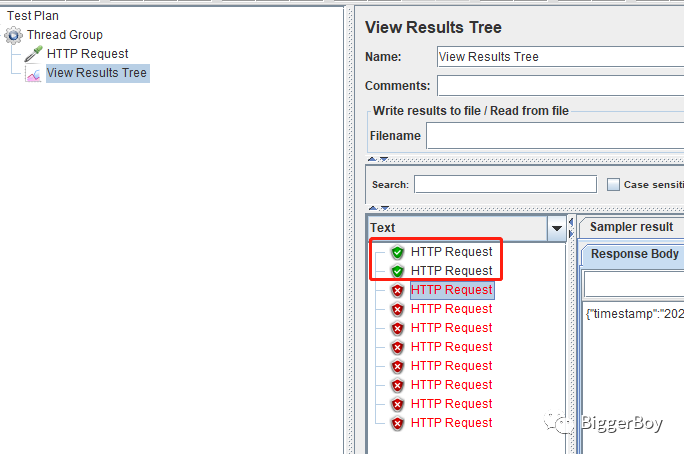
总结
以上 springboot + aop + Lua 限流实现是比较简单的,旨在让大家认识下什么是限流?如何做一个简单的限流功能,面试要知道这是个什么东西。上面虽然说了几种实现限流的方案,但选哪种还要结合具体的业务场景,不能为了用而用。在真正的场景里,不止设置一种限流规则,而是会设置多个限流规则共同作用,如连接数、访问频率、黑白名单、传输速率等。
源码地址:
https://gitee.com/it-wenbei/redis-limiter.git
参考:
https://www.cnblogs.com/h1763656169/articles/16554906.html
https://www.redis.net.cn/tutorial/3516.html
https://mp.weixin.qq.com/s/kyFAWH3mVNJvurQDt4vchA
文章转载自公众号:BiggerBoy




















